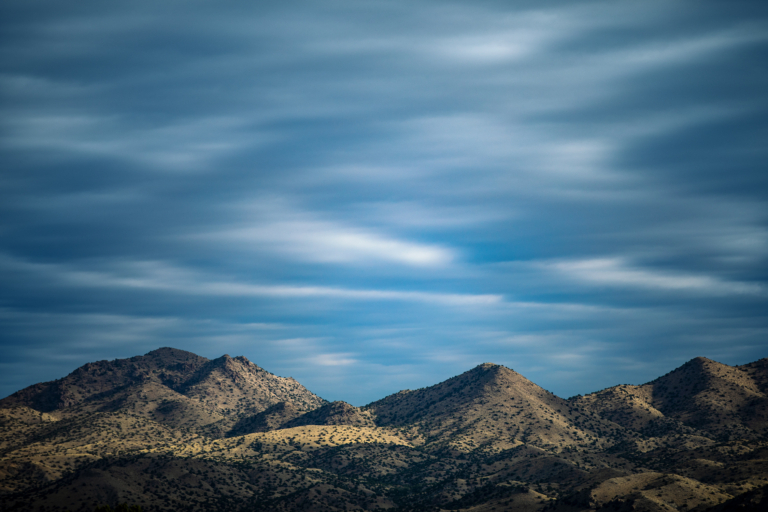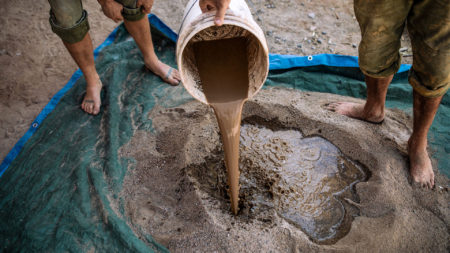Shaped by Clay
A Puebloan tradition is passed to the next generation.
All photos by Forest Woodward
Several weeks before she died, my mother woke me and said we needed to go to her land on the Madrid mesa. Her heart was failing, and she knew this was her last chance. We packed a simple lunch and closed the door of her house—a precious little adobe in Santa Clara Pueblo in northern New Mexico that she’d built with the help of her grandsons, my boys, Benito and Oso.
Over the years, my parents had built two small cabins under Madrid’s expansive skies—my father’s made of wood and my mother’s made of mud. For them, the mesa was a magical place of escape that had a way of diminishing most people-world problems, a perspective compounded by the rough four-wheel-drive-required road needed to get there.
I saw my mother’s face clench with every bump and jostle, so I decided to take a break before the steepest incline. We saw a pickup truck descending the mesa, and as it pulled up alongside our truck, my mother recognized the driver as the new neighboring landowner she had briefly met a few weeks earlier. This time he was with his partner, and they were scouting building locations before flying back East to their primary home. Saying our farewells, we continued up to the top of the mesa.

The original circularity. “My mother once asked her great-grandmother why a house with a large crack was not being fixed,” Athena recalls. “She was told with a finger shaking at her, ‘That is not your business. It has been a good house. It has been taken care of, fed, blessed and healed many times during its life, and now it is time for it to go back in the earth from where it came.’”
After a routine site check for wood rats, rattlers and wind damage, we entered the sun-warmed adobe space. My mother immediately lay down on the banco seat and breathed in the distant peak that she had designed to be perfectly centered in the span of the south-facing windows. “Creating center” was something my mother was always sensitive to and made me conscious of: such as how every ancient Pueblo site was chosen so that it felt like, and was, the center of the world.
As my mother’s exhaustion from the trip began to wane, I could feel in her silence a lingering apprehension about who these neighbors were and her fear of all the possible imbalances their building could create. Then a revelation struck us—Benito could do it! Of course. It was perfect. My son could build their place. He would know what to do and how to do it, but more importantly, it would be done from a deep love for and connection to the mesa. Benito was completely capable of “creating center.”
But how would we let them know? We had no names, no phone number and no way of knowing when they would return. Again, another brilliant solution—a message in a bottle! Like excited kids, we drafted a note and hunted for a suitable bottle. After closing up the building and saying our goodbyes, we headed out to leave our message on a pile of rocks next to the road.
Two weeks later, my mother died. But before she passed, our neighbors reached out—they’d found the bottle. They flew in for my mother’s memorial and, after, sat down with Benito to discuss the plans for their new adobe home. When he started work on the mesa, and I saw him harvesting clay, it took me back to one of our visits here long ago when Benito was 8. My mother had handed him a trowel and clay-plaster mix, showed him an empty wall and said, “Go ahead.”
This story was first published in the Patagonia Fall 2021 Journal.
These photos were made on the unceded lands of the Kewa (Santo Domingo) Pueblo Tribe, one of 19 Pueblos of New Mexico. Despite the arrival of multiple colonizing nations, these peoples continue to steward the lands and waters there; we have much to learn from them.
“When I was 8, on one of our visits to the mesa, my grandma handed me a trowel and said, ‘Go ahead,’” Benito Steen says. “Sometimes you do something and it feels as if it’s in your bones.”
“I come from a long line of people who work with clay—sculpting and building with earth,” says Benito. “Most of my mother’s side of the family live in Santa Clara Pueblo and work with clay in some way.”
“We have gathered rocks for the foundation, trees for the roof and dirt for the walls—connecting us to place,” says Benito.
“My roots are in Santa Clara Pueblo in New Mexico, where trees are few and far between so structures emerge up from the earth,” says Athena. “In Pueblo creation stories, people also emerge up out of the earth. Interconnected in our native language, Tewa, the word nang means both earth and us, the people. Nang formed walls, roofs, plasters and floors. Everyone was part of building.”
Jenna Pollard and Benito met four years ago on a timber-framing project in Costa Rica. When Benito invited her to help him with this project, she dropped everything and drove from Minnesota to the build site. “I didn’t get a tool list or introduction to the craft that I was expecting with adobe,” Jenna recalls. “Instead, I took off my shoes and copied Benito as he squished clay, water and straw between his toes and rolled the walrus-like mass in a tarp to a uniform consistency. I copied his hand movements as he floated and troweled clay plaster on the adobe walls. I took note when he added water to the wall, when he commented on the creaminess of the plaster’s texture under the right amount of pressure from the trowel.”
“Growing up, it was clear that there wasn’t any difference between art and building,” Benito recalls. “I would watch my mother work on our homes, sculpting what was a mistake on the wall into fluid, curving lines that enveloped the structure, or carving a simple design around a window to help you see the beauty inside or out.”
“Benito works with rock, clay, sand and straw in a way that is an extension of his body and mind,” Jenna says. “He seemingly doesn’t spend time thinking about the logistics of turning these raw materials into a livable space, but instead brings to life what’s already existing inside.”
“From adobes to timber frames, the heart of natural building lies in the transfer of knowledge, whether passed down through generations or shared with new friends,” says Jenna. “Benito and I lived and worked together in relative isolation throughout the summer and early fall. Laughter, storytelling and plain goofiness contributed to the energy in the space we created. And we watched every sunset while sitting on a dumpster-dive couch, talking about everything.”









